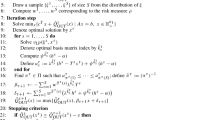Abstract
In classical two-stage stochastic programming the expected value of the total costs is minimized. Recently, mean-risk models - studied in mathematical finance for several decades - have attracted attention in stochastic programming. We consider Conditional Value-at-Risk as risk measure in the framework of two-stage stochastic integer programming. The paper addresses structure, stability, and algorithms for this class of models. In particular, we study continuity properties of the objective function, both with respect to the first-stage decisions and the integrating probability measure. Further, we present an explicit mixed-integer linear programming formulation of the problem when the probability distribution is discrete and finite. Finally, a solution algorithm based on Lagrangean relaxation of nonanticipativity is proposed.
Similar content being viewed by others
References
Acerbi, C., Tasche, D.: On the coherence of Expected Shortfall. Journal of Banking and Finance 26, 1487–1503 (2002)
Artstein, Z., Wets, R.J-B: Stability results for stochastic programs and sensors, allowing for discontinuous objective functions. SIAM J. Optim. 4, 537–550 (1994)
Artzner, P., Delbaen, F., Eber, J.-M., Heath, D.: Coherent measures of risk. Math. Finance 9, 203–228 (1999)
Bank, B., Guddat, J., Klatte, D., Kummer, B., Tammer, K.: Non-linear parametric optimization. Akademie-Verlag, Berlin (1982)
Bank, B., Mandel, R.: Parametric integer optimization. Akademie-Verlag, Berlin (1988)
Benson, H.P.: Multi-objective optimization: Pareto optimal solutions, properties. In: C.A. Floudas, P.M. Pardalos (eds.) Encyclopedia of optimization, Vol. III Kluwer, Dordrecht, 2001, pp 489–493
Billingsley, P.: Convergence of probability measures. Wiley, New York (1968)
Birge, J.R., Louveaux, F.: Introduction to stochastic programming. Springer, New York (1997)
Birge, J.R., Wets, R.J-B: Designing approximation schemes for stochastic optimization problems, in particular for stochastic programs with recourse. Math. Program. Study 27, 54–102 (1986)
Blair, C.E., Jeroslow, R.G.: The value function of a mixed integer program: I. Discrete Math. 19, 121–138 (1977)
Carøe, C.C., Schultz, R.: Dual decomposition in stochastic integer programming. Operations Res. Lett. 24, 37–45 (1999)
Engell, S., Märkert, A., Sand, G., Schultz, R.: Aggregated scheduling of a multiproduct batch plant by two-stage stochastic integer programming, Optimization and Engineering 5, 335–359 (2004)
Engell, S., Märkert, A., Sand, G., Schultz, R., Schulz, Ch.: Online scheduling of multiproduct batch plants under uncertainty. In: M. Grötschel, S.O. Krumke, J. Rambau (eds.) Online Optimization of Large Scale Systems. Springer, Berlin, 2001, pp 649–676
Helmberg, C., Kiwiel, K.C.: A spectral bundle method with bounds. Math. Programming 93, 173–194 (2002)
ILOG CPLEX, User's Manual (ILOG, Inc., Mountain View, CA 2002) Information available online from http://www.cplex.com.
Kall, P., Ruszczyński, A., Frauendorfer, K.: Approximation techniques in stochastic programming. In: Yu. Ermoliev, R.J-B Wets (eds.) Numerical techniques for stochastic optimization. Springer, Berlin, 1988, pp 33–64
Kall, P., Wallace, S.W.: Stochastic programming. Wiley, Chichester (1994)
Kiwiel, K.C.: Proximity control in bundle methods for convex nondifferentiable optimization. Math. Programming 46, 105–122 (1990)
Kiwiel, K.C.: User's Guide for NOA 2.0/3.0: A fortran package for convex nondifferentiable optimization. Systems Research Institute, Polish Academy of Sciences, Warsaw (1994)
Korhonen, P.: Multiple objective programming support. In: C.A. Floudas, P.M. Pardalos (eds.) Encyclopedia of optimization, Vol. III, Kluwer, Dordrecht, 2001, pp 566–574
Markowitz, H.M.: Portfolio selection. Journal of Finance 7, 77–91 (1952)
Nemhauser, G.L., Wolsey, L.A.: Integer and combinatorial optimization. Wiley, New York (1988)
Ogryczak, W., Ruszczyński, A.: From stochastic dominance to mean-risk models: Semideviations as risk measures. European J. Oper. Res. 116, 33–50 (1999)
Ogryczak, W., Ruszczyński, A.: Dual stochastic dominance and related mean-risk models. SIAM J. Optim. 13, 60–78 (2002)
Pflug, G.C.: Some remarks on the Value-at-Risk and the Conditional Value-at-Risk. In: S. Uryasev (ed.) Probabilistic constrained optimization: methodology and applications. Kluwer, Dordrecht, 2000 pp 272–281
Pollard, D.: Convergence of stochastic processes. Springer, New York (1984)
Prékopa, A.: Stochastic programming. Kluwer, Dordrecht (1995)
Robinson, S.M.: Local epi-continuity and local optimization. Math. Programming 37, 208–222 (1987)
Rockafellar, R.T., Uryasev, S.: Optimization of Conditional Value-at-Risk. Journal of Risk 2, 21–41 (2000)
Rockafellar, R.T., Uryasev, S.: Conditional Value-at-Risk for General Loss Distributions. Journal of Banking & Finance 26, 1443–1471 (2002)
Schultz, R.: On structure and stability in stochastic programs with random technology matrix and complete integer recourse. Math. Programming 70, 73–89 (1995)
Schultz, R.: Rates of convergence in stochastic programs with complete integer recourse. SIAM J. Optim. 6, 1138–1152 (1996)
Schultz, R., Tiedemann, S.: Risk Aversion via Excess Probabilities in Stochastic Programs with Mixed-Integer Recourse. SIAM J. Optim. 14, 115–138 (2003)
Tiedemann, S.: Risk measures with preselected tolerance levels in two-stage stochastic mixed-integer programming, Dissertation Thesis, Department of Mathematics, University Duisburg-Essen Cuvillier Verlag Göttingen (2005)
Author information
Authors and Affiliations
Corresponding author
Additional information
Received: April, 2004
Rights and permissions
About this article
Cite this article
Schultz, R., Tiedemann, S. Conditional Value-at-Risk in Stochastic Programs with Mixed-Integer Recourse. Math. Program. 105, 365–386 (2006). https://doi.org/10.1007/s10107-005-0658-4
Accepted:
Published:
Issue Date:
DOI: https://doi.org/10.1007/s10107-005-0658-4



